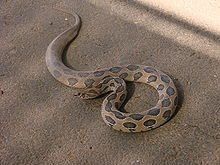Viperinae
| Viperinae | |
|---|---|
 |
|
| Russell's viper, Daboia russelii, a viperine | |
| Scientific classification | |
| Kingdom: | Animalia |
| Phylum: | Chordata |
| Class: | Reptilia |
| Order: | Squamata |
| Suborder: | Serpentes |
| Family: | Viperidae |
| Subfamily: |
Viperinae Oppel, 1811 |
| Synonyms | |
The Viperinae, or viperines, are a subfamily of venomous vipers endemic to Europe, Asia and Africa. They are distinguished by their lack of the heat-sensing pit organs that characterize their sister group, the subfamily Crotalinae. Currently, 12 genera and 66 species are recognized. Most are tropical and subtropical, although one species, Vipera berus, even occurs within the Arctic Circle.
Members of this subfamily range in size from Bitis schneideri, which grows to a maximum total length (body + tail) of only 710 mm (28 in), to Bitis gabonica, which reaches a maximum total length of over 2 m (6.6 ft). Most species are terrestrial, but a few, such as those of the genus Atheris, are completely arboreal.
Although the heat-sensing pits that characterize the Crotalinae are clearly lacking in the viperines, a supernasal sac with sensory function has been described in a number of species. This sac is an invagination of the skin between the supranasal and nasal scales and is connected to the ophthalmic branch of the trigeminal nerve. The nerve endings here resemble those in the labial pits of boas. The supernasal sac is present in the genera Daboia, Pseudocerastes and Causus, but is especially well developed in the genus Bitis. Experiments have shown that strikes are not only guided by visual and chemical cues, but also by heat, with warmer targets being struck more frequently than colder ones.
...
Wikipedia
